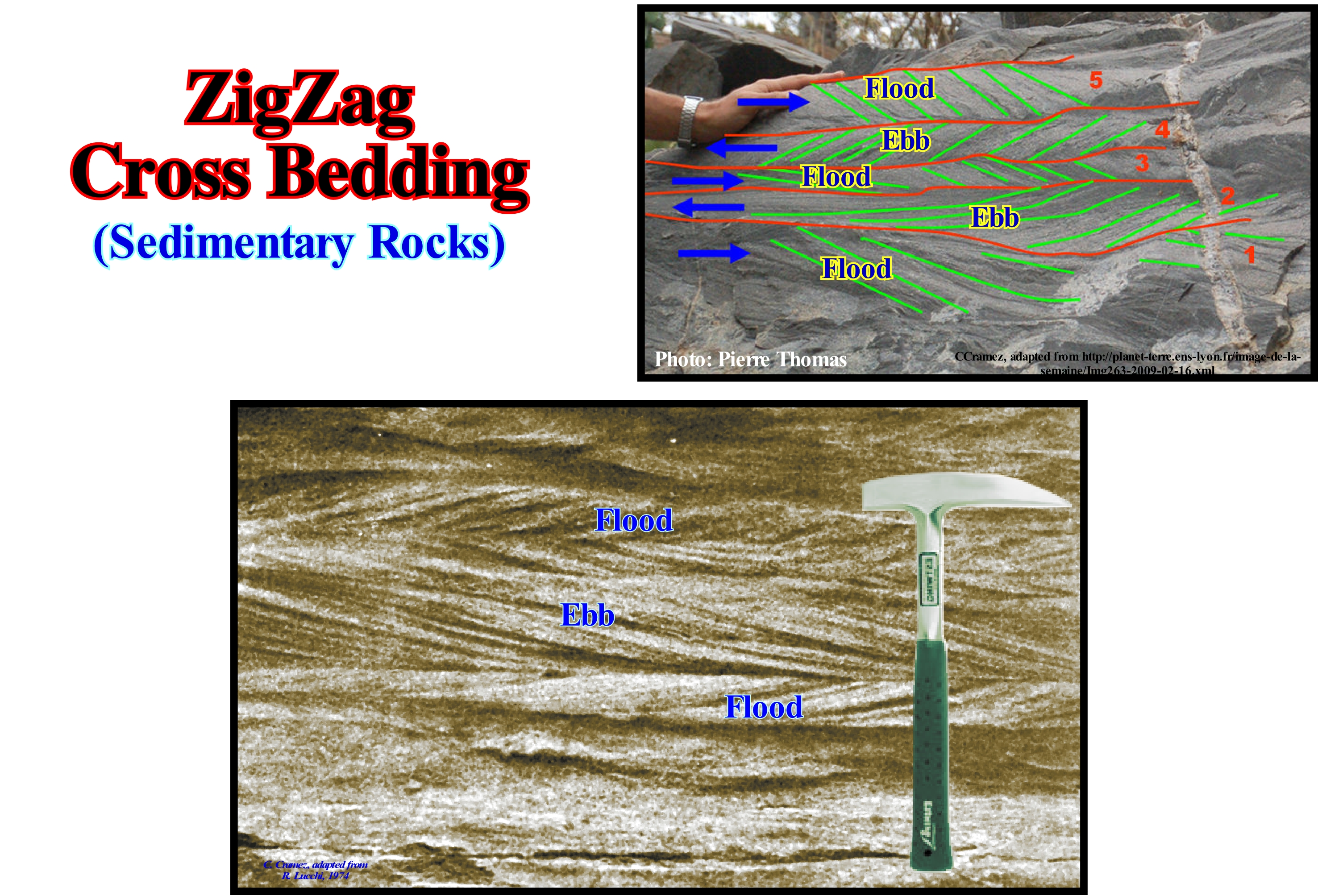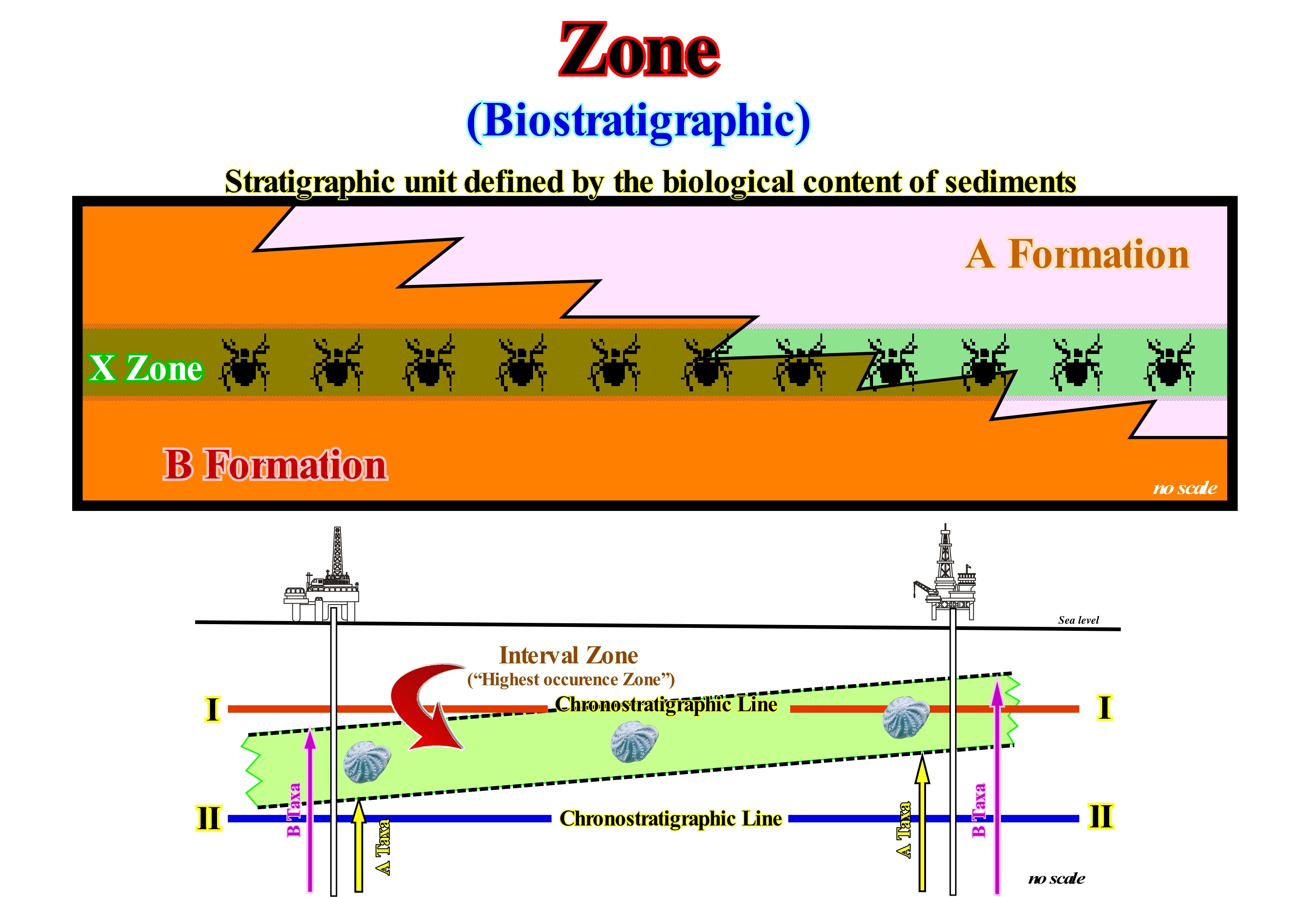

ZigZag Cross Bedding...........................................................................................................................Stratification entrecroisée
Estratificação Cruzada / Estratificación cruzada, Hummocky / Zick - Zack- Kreuz Betten / 曲折交错层理 / Диагональная зигзагообразная слоистость / Zigzag croce stratificazione /
When the bedding planes dip in different directions, sometimes opposite, in alternating layers forming a zigzag or fishbone geometry (herringbone cross-stratification*)
See: « Stratum »
&
« Stratification (sediments) »
&
« Lamina (sedimentary) »

A cross-bedding refers to a set of horizontal and inclined layers, in fluvial channels, tidal (fish-bone or chevron), delta fronts, dunes, etc., forming angles with neighbouring layers due to changes in direction of water or wind flow. A cross-bedding can be said to be a sedimentary structure, which can occur in several sedimentary environments in which the layers or laminae have dips that make angles with each other, without having had any erosional episode (unconformity). The different dips of the bedding planes are, essentially, due to the variations in the directions of the fluvial, marine or wind currents. This type of sedimentation can occur in fluvial channels, delta fronts or dunes, where the most common sedimentary particles are sands. In sections parallel to the direction of the bedding, this type of layering is similar to that produced by layers that are reciprocally inverted, as shown in this figure. In sections perpendicular to the direction of the layers the geometry is fusiform. The most important criterion for identifying this type of stratification is the recognition of the back and forth migration of bedding planes as illustrated above. This geometry can be recognized in the horizontal sections or in the three-dimensional blocks constructed from the vertical sections. This type of stratification is produced by transverse layers where the flow varies little, which causes that the less inclined side has opposite directions along the migration of the ridges. These structures indicate the directions of the paleocurrents, because they are deposited in transverse layers and, consequently, the slopes of the directions of the troughs indicate the direction of the paleocurrents. The size and uniformity of grain forms, as well as, the forms of cross bedding allow to determine the type of geological environment that gave rise to the rocks where they occur (http://sigep.cprm.gov.br/glossario/verbete/stratificaciónacao_cruzada.htm): (i) The beds and laminae sheets reach metric to decimetric dimensions, are asymptotic at the base of the set of crossed layers (at many points) and have matte grains (impact between the by wind force) of calibrated and rounded sand of middle grain-size ; (ii) Cross-bedding developed in fluvial channels may show sharp grain-size variations from mud (silt and clay) to coarse conglomerate fragments, more angular grains of sand, poorly defined beds, diagonal cross-bedding parallel to the flow and forming wedges or truncated "half moons" (sometimes filled by gravel transformed into a "cut and fill" conglomerate, if perpendicular) ; (iii) The cross-bedding of tidal beaches fills may be similar to fluvial, but the grain-size (fine to medium sand) is, generally, better calibrated. A zigzag cross-bedding, such as herringbone or chevron, is, usually, interpreted as formed in association with tidal currents : (i) The less sloping side in association with rising tide-current (flood) ; (ii) The other side,with higher dip, is associated with the descending tide-current (ebb). However, these sedimentary structures are not very frequent, since they require the current to be equal in both directions, which rarely happens in nature. The time period represented by each cross-stratified layer can be very important (many years),
(*) Sedimentary structure formed, generally, in tidal areas, where the current flows, periodically, in the opposite direction.
Zone (Stratigraphy)...................................................................................................................................................................................................................................Zone
Zone / Zona / Zone / 区 / Зона / Zona /
Strata in which occur a particular taxon or a combination of two taxa of any hierarchy. The zone is the basic unit of biostratigraphy, which is, also, called biozone. The geological time equivalent to a zone or biozone is the biochron. Biochronology is the branch of biostratigraphy that uses fossils to determine time intervals.
See: « Stratigraphy »
&
« Stratum »
&
« Infauna »

Conventionally, geoscientists have divided the stratigraphic records into three-dimensional rocky clusters, which they called "formations*" and which are composed of rocks of a particular type and origin. The formations are, relatively, homogeneous and, in the vast majority of cases, they are composed of a single type of rocks. In certain cases, as for instance, in deltas, geological formations may be formed by an alternation of different petrographic types (facies). Generally, geological formations are called geographically, i.e, they are named after the region, village, or river, where they outcrop and were first described (type section). Usually, a formation has a type section in a certain place where the upper and lower limits are well defined. The geological formations are composed of "members" and grouped together ("groups"), which can be combined into "supergroups" . All these geological entities (member, formation, group and supergroup) are lithostratigraphic and independent of the timelines. Its limits are not, necessarily, chronostratigraphic lines. Geoscientists have overlapped other rock classifications to the lithostratigraphic classifications, particularly, the biostratigraphy, which identifies and distinguishes strata by their fossiliferous content. The base unit of biostratigraphy, which is based on the temporal relations given by the fossils, is the "zone". A zone represents the time between the occurrence of one species, at the base of the zone, and the appearance of another species at the base of the next zone. A zone can be defined as a stratigraphic record characterized by: (i) A particular species of fossils ; (ii) An association of fossils or (iii) An acme or apogee interval of a species. Although the boundaries of the biostratigraphic zones are not, perfectly, parallel to the time-lines, the biostratigraphic classifications can, without great error, be considered as chronological classifications. The International Commission on Stratigraphy considers the ollowing type of zones (biozones): (i) Range Zones, in which can be distingued the a) Taxon-rane zones and b) Concurrent-range zones ; (ii) Interval zones ; (iii) Lineage zones ; (iv) Assemblage zones ; (v) Abondance zones.
(*) A geological formation is the basic unit of lithostratigraphy (study od strata or rocks layers, in which rock composition and the law of superposition and the principle of lateral continuity are paramount) consists of a certain amount of rock strata with similar facies (litholohy + associated fauna deposited in a given environment) independently of its thickness.
Zoobenthos........................................................................................................................................................................................................................................Zoobenthos
Zoobenthos / Zoobentos / Zoobenthos / 底栖动物 / Зообентос / Zoobenthos /
The term zoobenthos identifies and cover all the animal organisms of the benthos (all aquatic organisms, i.e., marine or freshwater, living near the bottom of water-bodies, i.e., seas, oceans, lakes and water-courses). Zoobenthos, which can be microscopic or macroscopic, are often refered as a subset of benthos. Zoobenthos are to the benthic environment, what zooplankton (small floating or weakly swimming organisms that drift with water currents) or zoopelagic are to the pelagic environment*.
See: « Benthos »
&
« Pelagic (organism) »
&
« Plankton »
Geoscientists call zoobenthos all animals and many heterotrophic protists living on the substrate of aquatic ecosystems. In marine biology and limnology**, benthos are organisms living in the substrate, fixed or not, as opposed to pelagics***, which live freely in the water column. Benthos or benthic organisms are those animals that live associated with sediment, both marine and continental, such as corals. Most geoscientists subdivide benthos into: (i) Phytobenthos: macroalgae, some microalgae and rooted aquatic plants and (ii) Zoobenthos: animals and many benthic protists, as illustrated in this figure. Within zoobenthos, three types of fauna can be considered: (a) Macrofauna: includes animals visible to the naked eye, like most crabs, echinoderms, insect larvae, oligochaeta worms (such as the earthworm, have the body covered by bristles, i.e., hairs, more or less coarse and rough and mucus, which facilitates movement by reducing friction, at the same time as aid to the formation of galleries by fixation of the ground) and some species of fish ; (b) Meiofauna: includes animals that live, permanently, buried in the sediment, whether free or within structures built by them, such as many molluscs, such as clams, and various types of worms and (c) Microfauna: consists of microscopic animals that grow on the substrate, mainly protists (unicellular or multicellular organisms and eukaryotes). Although zoobenthos are mostly studied in marine environments, they can also be studied in freshwater ecosystems such as flood plains and other wetlands. (http://en. wikipedia.org/wiki/Zoobentos).
(*) The pelagic environment comprehend the entire volume of water in the ocean and marine organisms that live above the ocean floor. It is divided into two zones: (i) The Oceanic zone i.e., the volume of water that cover all of the entire sea floor seaward of the shelf break and (ii) Neritc zone, i.e., the volume of water that cover all of the sea floor of continental shelf.
(**) A science that studies inland waters, regardless of their origins, but by checking the size and concentration of salts, in relation to flows of matter and energy and their biotic communities.
(***) Marine animals, free life, except for some crinoids that live attached to the rocky substratum and radial symmetry.
Zooplankton...........................................................................................................................................................................................................................Zooplancton
Zooplâncton / Zooplancton / Plancton (heterotrophen) / 浮游生物 (异) / Зоопланктон (животный планктон) / Plancton (eterotrofi) /
It is an animal plankton that feeds on living matter. Some species are herbivores and other carnivores. It is a heterotroph plankton organism (uses organic carbon to grow) and, sometimes, detritivore (gets food consuming debris). The zooplankton or zoopelagic organisms are to the pelagic environment, what the zoobenthos are to the benthic environment (comprises the bottom of the sediment surface, and some subsurface layers).
See: « Heterotrophic (organism) »
&
« Pelagic (organism) »
&
« Plankton »
The zooplankton encompasses organisms with a very varied size, from small protozoa to large metazoa. Zooplankton includes holoplanktonic organisms (opposed to hemiplankton, that spend part of their life cycle in a vegetative state on the sea bottom, riverbed), whose life cycle is, completely, made within the plankton, and meroplanktonic organisms, which spend a part of their life cycle on the plankton before moving to live on either the nekton or to a sessile benthic existence. Despite the fact that zooplankton is, essentially, carried by currents, many organisms can move vertical (vertical migration), mainly, to avoid predators or to increase the possibility of finding prey. The foraminifera*, radiolaria and dinoflagellates**, are the protozoan groups of zooplankton, probably, more important from the ecological point of view. As metazoans of the zooplankton we can mention the cnidarians such as jellyfish and the Portuguese caravel (Physalia physalis) or blue bottle, crustaceans such as copepods and krill (invertebrate animals similar to shrimp), arrow-worms (chaetognatha) ; molluscs and chordates, such as the salps (small jellyfish an inch in size in the cold seas) and young fish. This broad phylogenetic range translates into different eating behaviours: (i) Filtration; (ii) Predation and (iii) Symbiosis with autotrophic phytoplankton. As zooplankton feeds on bacterial plankton, phytoplankton, other zooplankton, debris (or "sea snow") and even nektonic organisms, it is found mostly in surface waters where food resources (phytoplankton and other zooplankton) are more abundant. (http://en.wikipedia.org/wiki/Zooplankton)
(*)Unicellular protozoa that appeared in the Early Cambrian (540 Ma), which developed mainly from the Triassic. Their mineral shell is called "test" ; it comprises one or more rooms (or loculus or boxes) connected to each other, and is provided with one or more orifices ("foramen") which connect these boxes to the outside environment. From these foramen come pseudopods, which allow the organism to interact with its environment: prehension, diet, displacement.
(**) Any of numerous one-celled aquatic organisms bearing two dissimilar flagella and having characteristics of both plants and animals. Most are marine, though some live in freshwater habitats. The group is an important component of phytoplankton in all but the colder seas and is an important link in the food chain . Dinoflagellates also produce some of the bioluminescence sometimes seen in the sea. (https://www.britannica.com/science/dinoflagellate)
Send E-mails to carloscramez@gmail.com or to carlos.cramez@bluewin.ch with comments and suggestions to improve this glossary.
Copyright © 2009 CCramez, Switzerland
Last updated: September, 2019